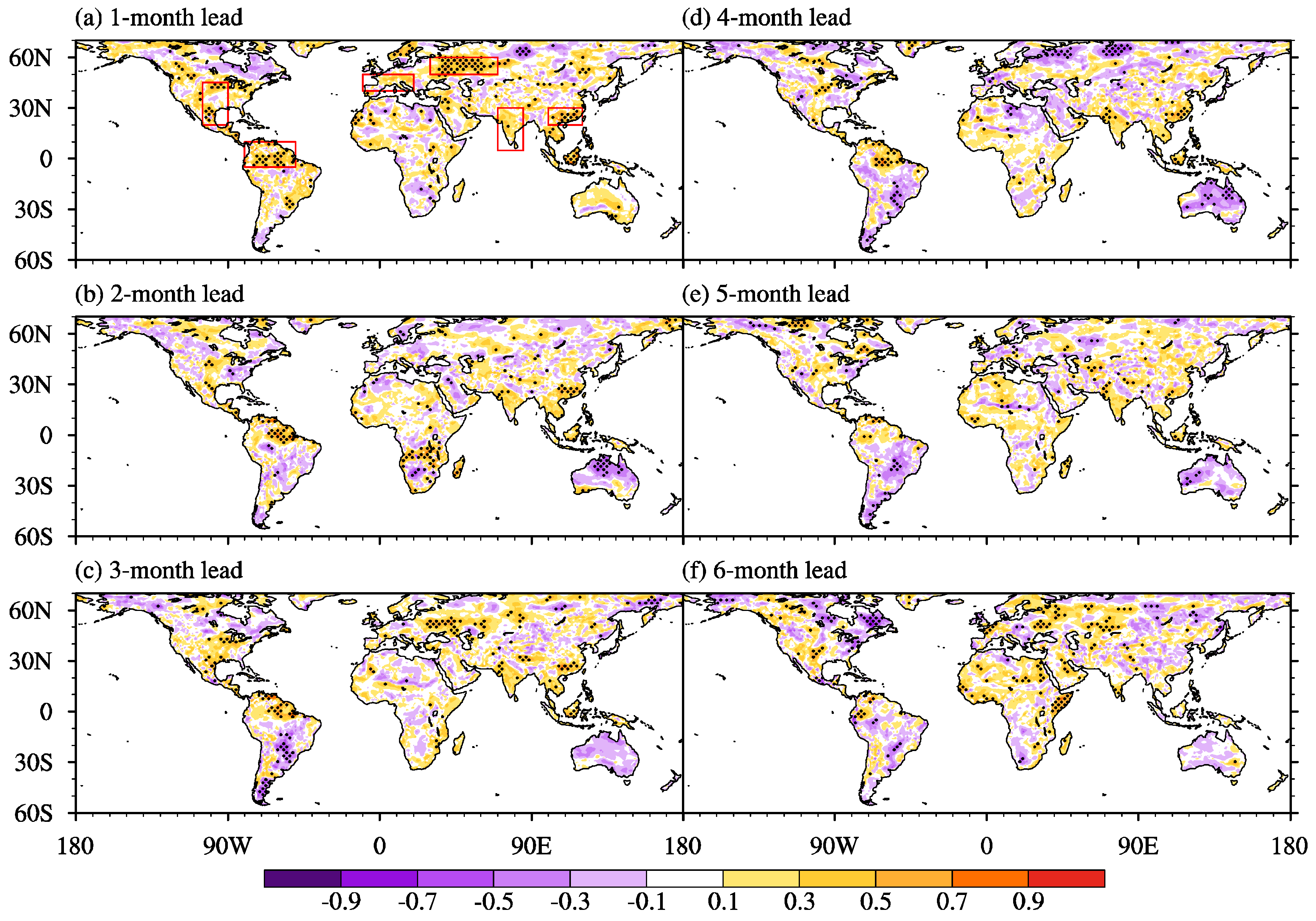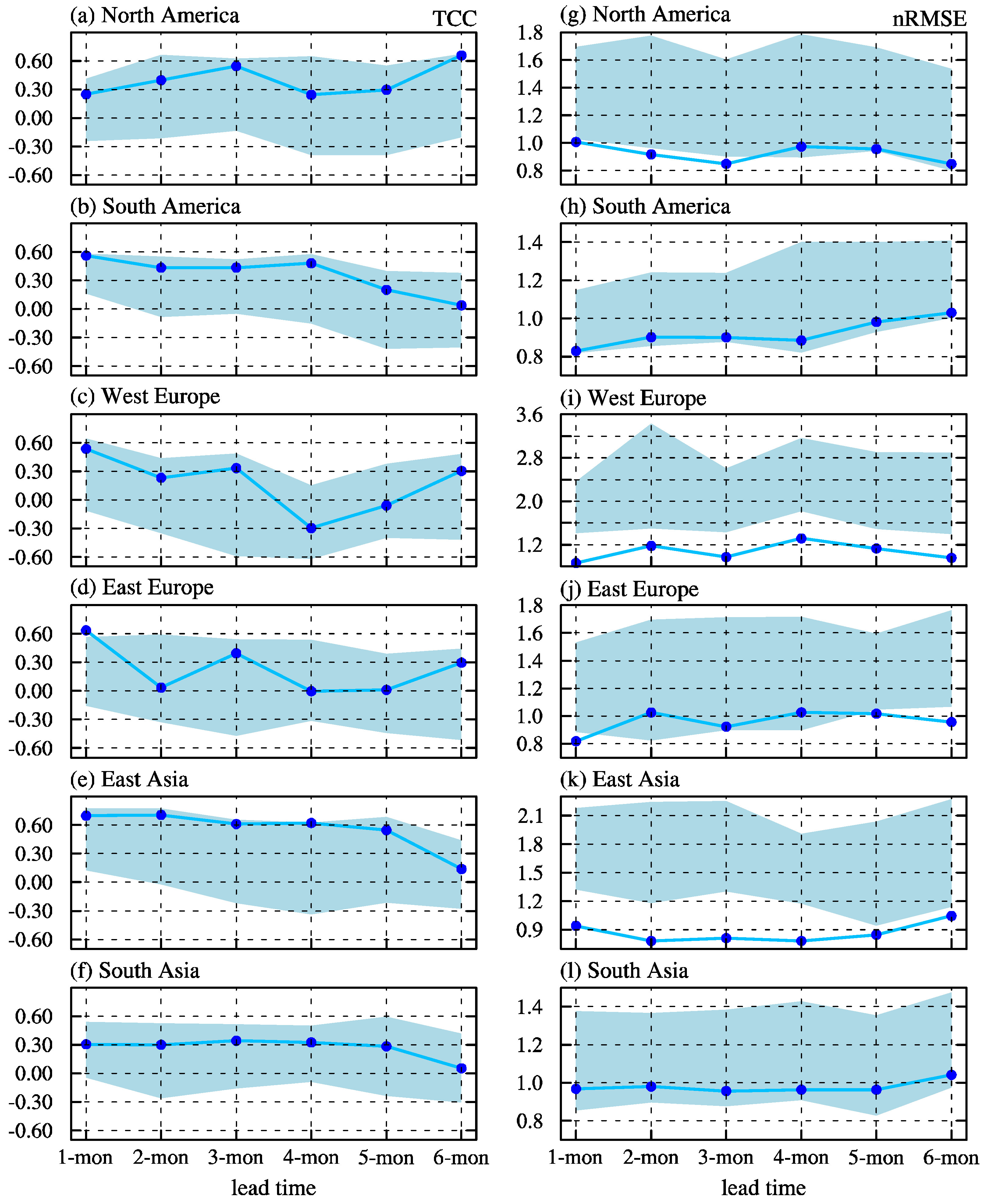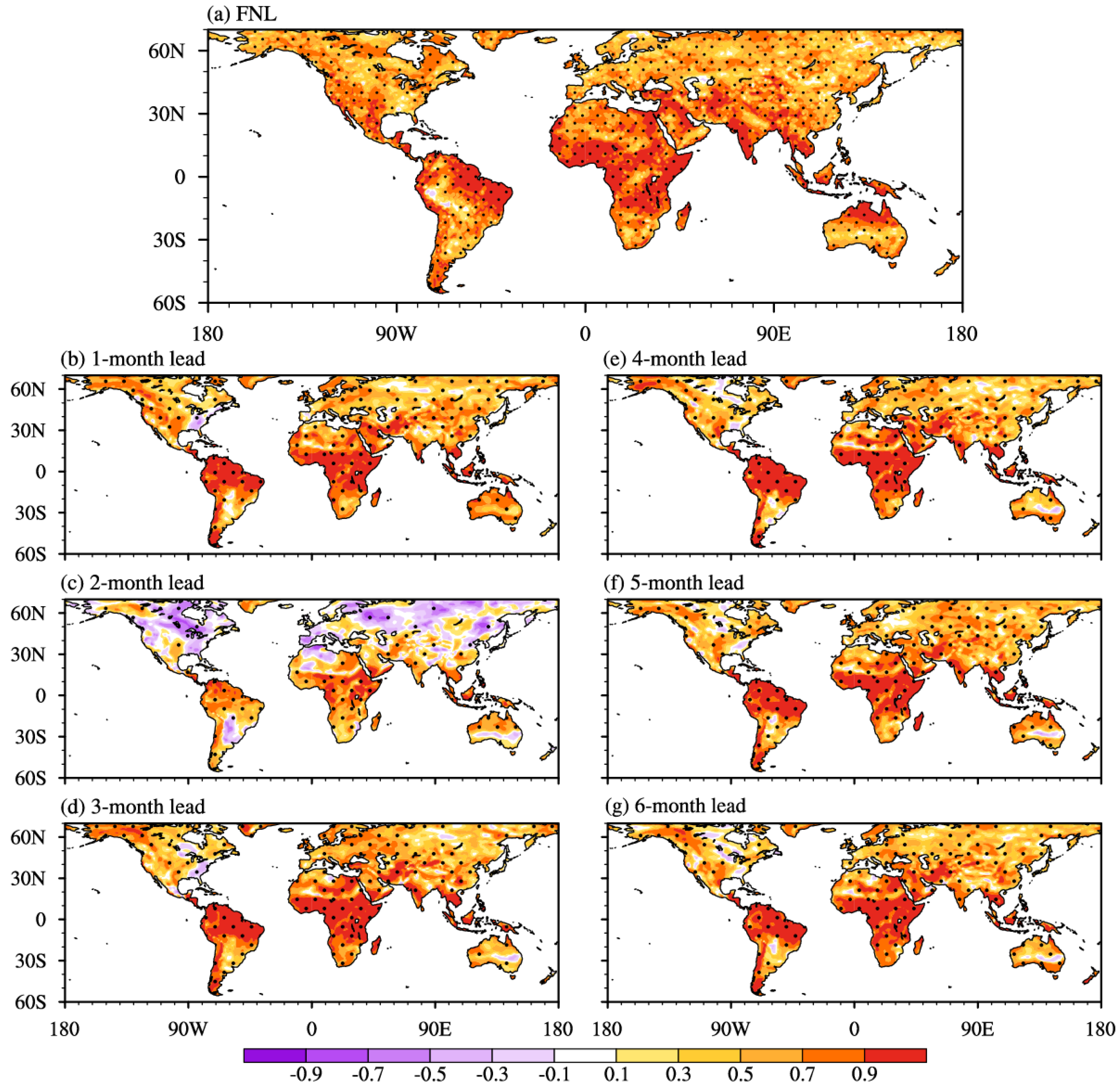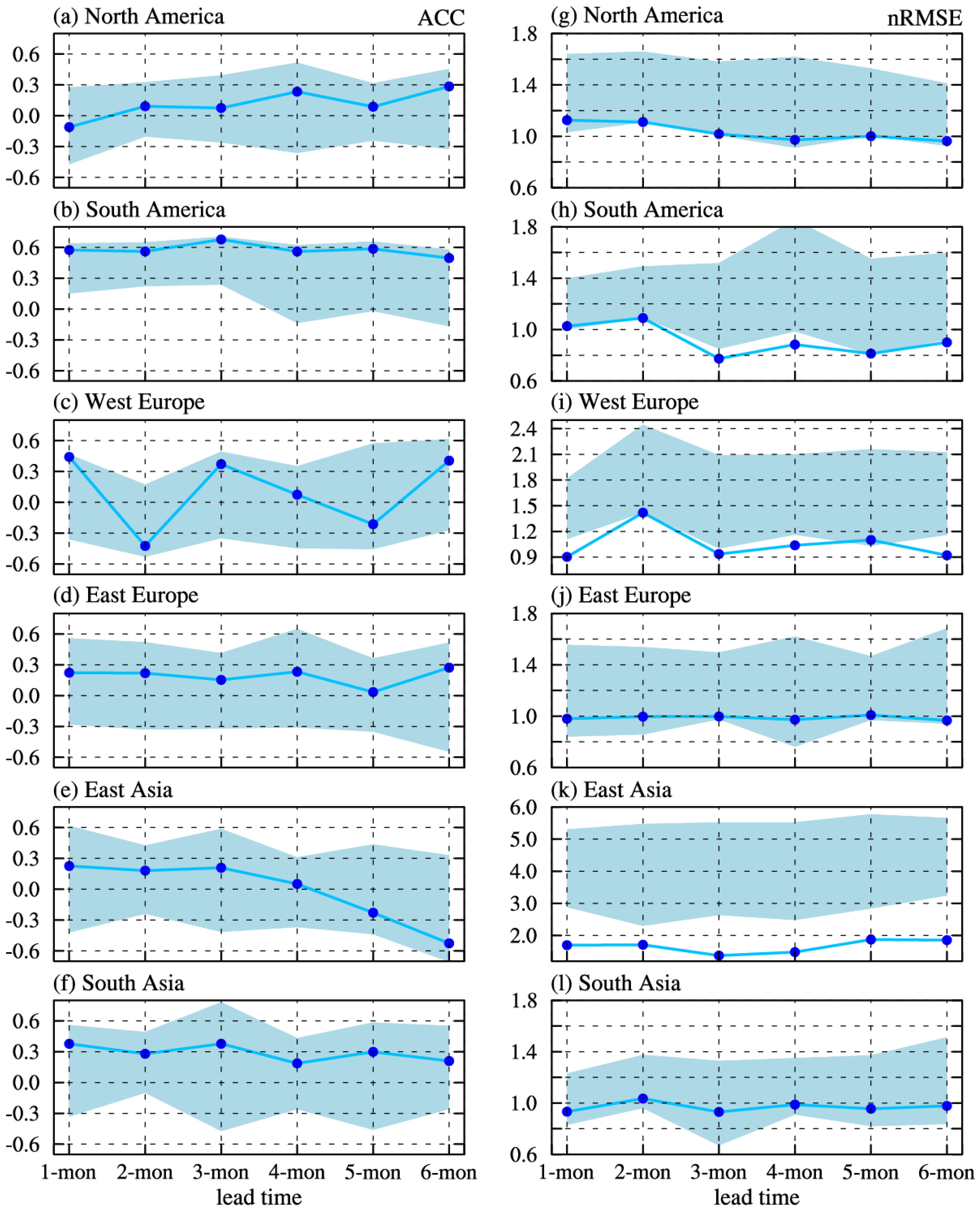Skillful Seasonal Prediction of Global Onshore Wind Resources in SIDRI-ESS V1.0
Abstract
:1. Introduction
2. Data and Methods
2.1. Observation-Based Data
2.2. Model Description
2.3. Experiments Design
2.4. Verified Method
3. Results
3.1. Simulation of Climatology
3.2. Seasonal Prediction Skill for 10 m Wind Speed
3.3. Seasonal Prediction for Wind Energy Generation
4. Summary and Discussion
Author Contributions
Funding
Institutional Review Board Statement
Informed Consent Statement
Data Availability Statement
Conflicts of Interest
References
- Barthelmie, R.J.; Pryor, S.C. Potential contribution of wind energy to climate change mitigation. Nat. Clim. Chang. 2014, 4, 684–688. [Google Scholar] [CrossRef]
- Bonou, A.; Laurent, A.; Olsen, S.I. Life cycle assessment of onshore and offshore wind energy-from theory to application. Appl. Energy 2016, 180, 327–337. [Google Scholar] [CrossRef]
- GWEC. Global Wind Report 2022; Global Wind Energy Council: Brussels, Belgium, 2023. [Google Scholar]
- Roulston, M.S.; Kaplan, D.T.; Hardenberg, J.; Smith, L.A. Using medium-range weather forcasts to improve the value of wind energy production. Renew. Energy 2003, 28, 585–602. [Google Scholar] [CrossRef]
- Clark, R.T.; Bett, P.E.; Thornton, H.E.; Scaife, A.A. Skilful seasonal predictions for the European energy industry. Environ. Res. Lett. 2017, 12, 024002. [Google Scholar] [CrossRef]
- Torralba, V.; Doblas-Reyes, F.J.; MacLeod, D.; Christel, I.; Davis, M. Seasonal Climate Prediction: A New Source of Information for the Management of Wind Energy Resources. J. Appl. Meteorol. Climatol. 2017, 56, 1231–1247. [Google Scholar] [CrossRef]
- White, C.J.; Carlsen, H.; Robertson, A.W.; Klein, R.J.T.; Lazo, J.K.; Kumar, A.; Vitart, F.; Coughlan de Perez, E.; Ray, A.J.; Murray, V.; et al. Potential applications of subseasonal-to-seasonal (S2S) predictions. Meteorol. Appl. 2017, 24, 315–325. [Google Scholar] [CrossRef]
- Staffell, I.; Pfenninger, S. The increasing impact of weather on electricity supply and demand. Energy 2018, 145, 65–78. [Google Scholar] [CrossRef]
- Orlov, A.; Sillmann, J.; Vigo, I. Better seasonal forecasts for the renewable energy industry. Nat. Energy 2020, 5, 108–110. [Google Scholar] [CrossRef]
- Wiatros-Motyka, M.; Fulghum, N.; Jones, D. Global Electricity Review 2024; Ember: Atlanta, GA, USA, 2024. [Google Scholar]
- EI. Energy Institute Statistical Review of World Energy 2024; EI: Tokyo, Japan, 2024. [Google Scholar]
- Lange, B.; Rohrig, K.; Ernst, B. Wind power forecasting in Germany—Recent advances and future challenges. Z. Für Energiewirtschaft 2006, 30, 115–120. [Google Scholar]
- De Giorgi, M.G.; Ficarella, A.; Tarantino, M. Error analysis of short term wind power prediction models. Appl. Energy 2011, 88, 1298–1311. [Google Scholar] [CrossRef]
- Wang, Y.; Zou, R.; Liu, F.; Zhang, L.; Liu, Q. A review of wind speed and wind power forecasting with deep neural networks. Appl. Energy 2021, 304, 117766. [Google Scholar] [CrossRef]
- Foley, A.M.; Leahy, P.G.; Marvuglia, A.; McKeogh, E.J. Current methods and advances in forecasting of wind power generation. Renew. Energy 2012, 37, 1–8. [Google Scholar] [CrossRef]
- Enloe, J.; O’Brien, J.J.; Smith, S.R. ENSO Impacts on Peak Wind Gusts in the United States. J. Clim. 2004, 17, 1728–1737. [Google Scholar] [CrossRef]
- Brayshaw, D.J.; Troccoli, A.; Fordham, R.; Methven, J. The impact of large scale atmospheric circulation patterns on wind power generation and its potential predictability: A case study over the UK. Renew. Energy 2011, 36, 2087–2096. [Google Scholar] [CrossRef]
- Hamlington, B.D.; Hamlington, P.E.; Collins, S.G.; Alexander, S.R.; Kim, K.-Y. Effects of climate oscillations on wind resource variability in the United States. Geophys. Res. Lett. 2015, 42, 145–152. [Google Scholar] [CrossRef]
- Sherman, P.; Chen, X.; McElroy, M.B. Wind-generated Electricity in China: Decreasing Potential, Inter-annual Variability and Association with Changing Climate. Sci. Rep. 2017, 7, 16294. [Google Scholar] [CrossRef]
- Xu, Q.; Chen, W.; Song, L. Two Leading Modes in the Evolution of Major Sudden Stratospheric Warmings and Their Distinctive Surface Influence. Geophys. Res. Lett. 2022, 49, e2021GL095431. [Google Scholar] [CrossRef]
- Bett, P.E.; Thornton, H.E.; Lockwood, J.F.; Scaife, A.A.; Golding, N.; Hewitt, C.; Zhu, R.; Zhang, P.; Li, C. Skill and Reliability of Seasonal Forecasts for the Chinese Energy Sector. J. Appl. Meteorol. Climatol. 2017, 56, 3099–3114. [Google Scholar] [CrossRef]
- Lee, D.Y.; Doblas-Reyes, F.J.; Torralba, V.; Gonzalez-Reviriego, N. Multi-model seasonal forecasts for the wind energy sector. Clim. Dyn. 2019, 53, 2715–2729. [Google Scholar] [CrossRef]
- Lockwood, J.F.; Thornton, H.E.; Dunstone, N.; Scaife, A.A.; Bett, P.E.; Li, C.; Ren, H.-L. Skilful seasonal prediction of winter wind speeds in China. Clim. Dyn. 2019, 53, 3937–3955. [Google Scholar] [CrossRef]
- Soret, A.; Torralba, V.; Cortesi, N.; Christel, I.; Palma, L.; Manrique-Suñén, A.; Lledó, L.; González-Reviriego, N.; Doblas-Reyes, F.J. Sub-seasonal to seasonal climate predictions for wind energy forecasting. J. Phys. Conf. Ser. 2019, 1222, 012009. [Google Scholar] [CrossRef]
- Zeng, P.; Sun, X.; Farnham, D.J. Skillful statistical models to predict seasonal wind speed and solar radiation in a Yangtze River estuary case study. Sci. Rep. 2020, 10, 8597. [Google Scholar] [CrossRef] [PubMed]
- Bett, P.E.; Thornton, H.E.; Troccoli, A.; De Felice, M.; Suckling, E.; Dubus, L.; Saint-Drenan, Y.-M.; Brayshaw, D.J. A simplified seasonal forecasting strategy, applied to wind and solar power in Europe. Clim. Serv. 2022, 27, 100318. [Google Scholar] [CrossRef]
- Lockwood, J.F.; Stringer, N.; Hodge, K.R.; Bett, P.E.; Knight, J.; Smith, D.; Scaife, A.A.; Patterson, M.; Dunstone, N.; Thornton, H.E. Seasonal prediction of UK mean and extreme winds. Q. J. R. Meteorol. Soc. 2023, 149, 3477–3489. [Google Scholar] [CrossRef]
- Yang, X.; Delworth, T.L.; Jia, L.; Johnson, N.C.; Lu, F.; McHugh, C. Skillful seasonal prediction of wind energy resources in the contiguous United States. Commun. Earth Environ. 2024, 5, 313. [Google Scholar] [CrossRef]
- Troccoli, A.; Goodess, C.; Jones, P.; Penny, L.; Dorling, S.; Harpham, C.; Dubus, L.; Parey, S.; Claudel, S.; Khong, D.H.; et al. Creating a proof-of-concept climate service to assess future renewable energy mixes in Europe: An overview of the C3S ECEM project. Adv. Sci. Res. 2018, 15, 191–205. [Google Scholar] [CrossRef]
- Pan, B.; Anderson, G.J.; Goncalves, A.; Lucas, D.D.; Bonfils, C.J.W.; Lee, J. Improving Seasonal Forecast Using Probabilistic Deep Learning. J. Adv. Model. Earth Syst. 2022, 14, e2021MS002766. [Google Scholar] [CrossRef]
- El-Azab, H.A.; Swief, R.; El-Amary, N.; Temraz, H. Seasonal Forecasting of Wind and Solar Power Using Deep Learning Algorithms. In Proceedings of the 2023 24th International Middle East Power System Conference (MEPCON), Mansoura, Egypt, 19–21 December 2023; pp. 1–8. [Google Scholar]
- Tong, X.; Zhou, W.; Xia, J. Improving Boreal Summer Precipitation Predictions From the Global NMME Through Res34-Unet. Geophys. Res. Lett. 2024, 51, e2023GL106391. [Google Scholar] [CrossRef]
- National Centers for Environmental Prediction/National Weather Service/NOAA/U.S. Department of Commerce, 2000: NCEP FNL Operational Model Global Tropospheric Analyses, Continuing from July 1999. Research Data Archive at the National Center for Atmospheric Research, Computational and Information Systems Laboratory. 19 July. Available online: https://doi.org/10.5065/D6M043C6 (accessed on 27 March 2023).
- Lin, S.-J. A “Vertically Lagrangian” Finite-Volume Dynamical Core for Global Models. Mon. Weather Rev. 2004, 132, 2293–2307. [Google Scholar] [CrossRef]
- Putman, W.M.; Lin, S.-J. Finite-volume transport on various cubed-sphere grids. J. Comput. Phys. 2007, 227, 55–78. [Google Scholar] [CrossRef]
- Smith, R.D.; Jones, P.; Briegleb, B.; Bryan, F.; Danabasoglu, G.; Dennis, J.; Dukowicz, J.; Eden, C.; Fox-Kemper, B.; Gent, P.; et al. The Parallel Ocean Program (POP) Reference Manual; Technical Report for Los Alamos National Labora-tory LAUR-10-01853; Los Alamos National Laboratory: Los Alamos, NM, USA, 2010; p. 140. [Google Scholar]
- Oleson, K.W.; Lawrence, D.M.; Gordon, B.; Flanner, M.G.; Kluzek, E.; Peter, J.; Levis, S.; Swenson, S.C.; Thornton, E.; Feddema, J. Technical Description of Version 4.0 of the Community land Model (CLM); National Center for At-mospheric Research: Boulder, CO, USA, 2010. [Google Scholar]
- Hunke, E.; Lipscomb, W. CICE: The Los Alamos Sea Ice Model Documentation and Software User’s Manual Version 4.0; Tech. Rep. LA–CC–06–012; Los Alamos National Laboratory: Los Alamos, NM, USA, 2010. [Google Scholar]
- Bloom, S.C.; Takacs, L.L.; da Silva, A.M.; Ledvina, D. Data Assimilation Using Incremental Analysis Updates. Mon. Weather Rev. 1996, 124, 1256–1271. [Google Scholar] [CrossRef]
- Magnusson, L.; Alonso-Balmaseda, M.; Corti, S.; Molteni, F.; Stockdale, T. Evaluation of forecast strategies for seasonal and decadal forecasts in presence of systematic model errors. Clim. Dyn. 2013, 41, 2393–2409. [Google Scholar] [CrossRef]
- Wang, C.; Zhang, L.; Lee, S.-K.; Wu, L.; Mechoso, C.R. A global perspective on CMIP5 climate model biases. Nat. Clim. Chang. 2014, 4, 201–205. [Google Scholar] [CrossRef]
- Russo, S.; Sillmann, J.; Fischer, E.M. Top ten European heatwaves since 1950 and their occurrence in the coming decades. Environ. Res. Lett. 2015, 10, 124003. [Google Scholar] [CrossRef]
- Buizza, R.; Palmer, T.N. Impact of Ensemble Size on Ensemble Prediction. Mon. Weather Rev. 1998, 126, 2503–2518. [Google Scholar] [CrossRef]
- Ma, J.; Zhu, Y.; Wobus, R.; Wang, P. An effective configuration of ensemble size and horizontal resolution for the NCEP GEFS. Adv. Atmos. Sci. 2012, 29, 782–794. [Google Scholar] [CrossRef]
- Han, Y.; Mi, L.; Shen, L.; Cai, C.S.; Liu, Y.; Li, K.; Xu, G. A short-term wind speed prediction method utilizing novel hybrid deep learning algorithms to correct numerical weather forecasting. Appl. Energy 2022, 312, 118777. [Google Scholar] [CrossRef]
- Tong, X.; Li, J.; Zhang, F.; Li, W.; Pan, B.; Li, J.; Letu, H. The Deep-Learning-Based Fast Efficient Nighttime Retrieval of Thermodynamic Phase From Himawari-8 AHI Measurements. Geophys. Res. Lett. 2023, 50, e2022GL100901. [Google Scholar] [CrossRef]
- Zhao, J.; Guo, Y.; Lin, Y.; Zhao, Z.; Guo, Z. A novel dynamic ensemble of numerical weather prediction for multi-step wind speed forecasting with deep reinforcement learning and error sequence modeling. Energy 2024, 302, 131787. [Google Scholar] [CrossRef]
- Klyuev, R.; Bosikov, I.; Gavrina, O. Use of Wind Power Stations for Energy Supply to Consumers in Mountain Territories. In Proceedings of the 2019 International Ural Conference on Electrical Power Engineering (UralCon), Chelyabinsk, Russia, 1–3 October 2019; pp. 116–121. [Google Scholar]
- Han, J.; Wang, X.; Yang, X.; Ling, Q.; Liu, W. Yaw system restart strategy optimization of wind turbines in mountain wind farms based on operational data mining and multi-objective optimization. Eng. Appl. Artif. Intell. 2023, 126, 107036. [Google Scholar] [CrossRef]









| Citations | Forecast System | Prediction Skill |
|---|---|---|
| Bett et al. [21] | GloSea5 | Focusing on seasonal prediction for 10 m wind speed (ws10m) over China, the maximum TCC (0.58) for ws10m was found in Yunnan region at a 1-month lead time. |
| Lee et al. [22] | ECMWF System4 Météo-France System3 Météo-France System4 Météo-France System5 | Significant fair ranked probability skill score (FRPSS) for ws10m concentrates on Maritime Continent and India (values reach about 0.5). |
| Bett et al. [26] | GloSea5 Météo-France System5 ECMWF System4 | Skills are patchy among different systems over Europe with negative TCC for most regions at a 1-month lead time. |
| Lockwood et al. [27] | GloSea5 GloSea6 | Focusing on prediction skill for ws10m over UK, the TCC is only about −0.3 at a 1-month lead time. |
| Yang et al. [28] | GFDL-SPEAR | Focusing on prediction skill for wind power over U.S. Great Plains, the TCC for Northern (Southern) Great Plains reach about 0.4–0.5 (0.3–0.4) at a 1-month lead time. |
| Region | 1-Month | 2-Month | 3-Month | 4-Month | 5-Month | 6-Month |
|---|---|---|---|---|---|---|
| North America | 0.25 | 0.40 | 0.54 | 0.24 | 0.30 | 0.66 |
| South America | 0.56 | 0.43 | 0.43 | 0.48 | 0.20 | 0.04 |
| Western Europe | 0.54 | 0.23 | 0.33 | −0.30 | −0.06 | 0.30 |
| Eastern Europe | 0.64 | 0.03 | 0.40 | 0.00 | 0.01 | 0.30 |
| East Asia | 0.70 | 0.71 | 0.61 | 0.62 | 0.55 | 0.14 |
| South Asia | 0.30 | 0.30 | 0.34 | 0.32 | 0.28 | 0.05 |
| Region | 1-Month | 2-Month | 3-Month | 4-Month | 5-Month | 6-Month |
|---|---|---|---|---|---|---|
| North America | 1.00 | 0.92 | 0.85 | 0.97 | 0.96 | 0.85 |
| South America | 0.83 | 0.90 | 0.90 | 0.88 | 0.98 | 1.03 |
| Western Europe | 0.87 | 1.18 | 0.97 | 1.32 | 1.13 | 0.96 |
| Eastern Europe | 0.82 | 1.03 | 0.92 | 1.03 | 1.02 | 0.96 |
| East Asia | 0.94 | 0.78 | 0.81 | 0.78 | 0.85 | 1.05 |
| South Asia | 0.97 | 0.98 | 0.96 | 0.96 | 0.96 | 1.04 |
Disclaimer/Publisher’s Note: The statements, opinions and data contained in all publications are solely those of the individual author(s) and contributor(s) and not of MDPI and/or the editor(s). MDPI and/or the editor(s) disclaim responsibility for any injury to people or property resulting from any ideas, methods, instructions or products referred to in the content. |
© 2024 by the authors. Licensee MDPI, Basel, Switzerland. This article is an open access article distributed under the terms and conditions of the Creative Commons Attribution (CC BY) license (https://creativecommons.org/licenses/by/4.0/).
Share and Cite
Yan, Z.; Zhou, W.; Li, J.; Zhu, X.; Zang, Y.; Zhang, L. Skillful Seasonal Prediction of Global Onshore Wind Resources in SIDRI-ESS V1.0. Sustainability 2024, 16, 7721. https://doi.org/10.3390/su16177721
Yan Z, Zhou W, Li J, Zhu X, Zang Y, Zhang L. Skillful Seasonal Prediction of Global Onshore Wind Resources in SIDRI-ESS V1.0. Sustainability. 2024; 16(17):7721. https://doi.org/10.3390/su16177721
Chicago/Turabian StyleYan, Zixiang, Wen Zhou, Jinxiao Li, Xuedan Zhu, Yuxin Zang, and Liuyi Zhang. 2024. "Skillful Seasonal Prediction of Global Onshore Wind Resources in SIDRI-ESS V1.0" Sustainability 16, no. 17: 7721. https://doi.org/10.3390/su16177721
APA StyleYan, Z., Zhou, W., Li, J., Zhu, X., Zang, Y., & Zhang, L. (2024). Skillful Seasonal Prediction of Global Onshore Wind Resources in SIDRI-ESS V1.0. Sustainability, 16(17), 7721. https://doi.org/10.3390/su16177721






